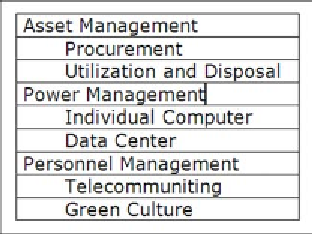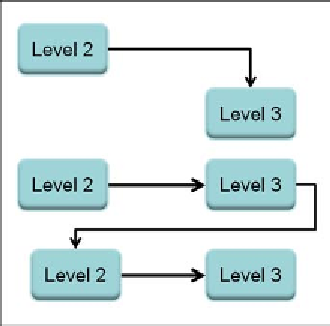Environmental Engineering Reference
In-Depth Information
Figure 4. GITM Key process areas
Figure 5. Waterfall vs. iterative approach
3. Activities performed
4. Measurement and analysis
5. Verifying implementation
attained level is sometimes required to make
long-term progress possible.
In applying GITM, organizations should delin-
eate these Common Features in all Key Process
Areas, so that specification of Key Practices could
be determined. Within each Process Area, a de-
tailed identification of Key Practices is likely to
be dependent on specific organizational settings.
GITM Level 4: Optimized
The distinguishing feature of Level 4 (Optimized)
is the introduction of Total Quality Management
(TQM) techniques to greening. This is about
having an on-going, continuous effort to improve
some aspect of the organization's operation,
production, or service activities. The intent is to
create an organizational culture that goes beyond
policies and programs, and in contrast to Level 3
becomes autonomous in its capability to initiate
and execute.
Level 4 could be treated as the nirvana level,
toward which efforts are constantly expanded but
the end of being completely optimized is never
quite reached. This is a program that constantly
addresses some issue that could be improved upon
in a constant and continuous, circular, fashion.
The organization is always looking for something
to improve upon and this effort -- over time -- leads
to tighter, more effective and more efficient pro-
cesses that accomplish GITM goals of reduced
waste and enhanced sustainability. (Figure 7)
GITM Level 3: Managed
Once programs, policies, and initiatives - in
context of process definition and redefinition -
have been put in place, the next logical step is to
focus on measuring the effects of what is being
done. Management of the greening efforts be-
comes possible when performance is monitored
and measured and when policies in response to
observed results can be adopted and adapted. The
intent here is to measure costs and benefits and to
try to manage the efforts in an attempt to obtain
the greatest greening bang for the resource buck.
It should be made clear that a transition between
Level 2 and Level 3 is not a one-way, waterfall
progression. Identification of new greening pro-
cesses can certainly be done well after Level 3
had already been achieved for older processes.
This is akin to the “iterative” method of software
development, in which going back to a previously


